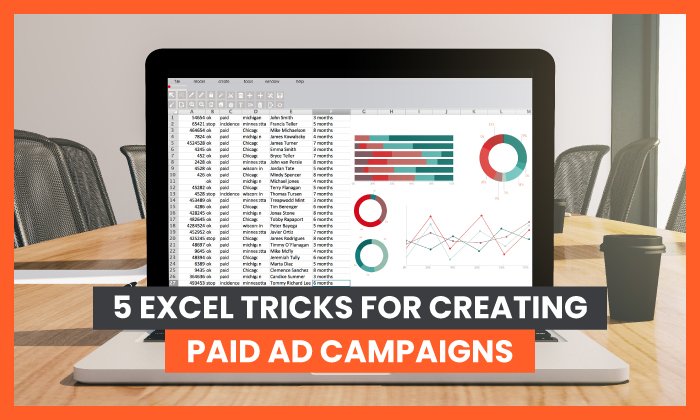5 Excel Tricks for Creating Paid Ad Campaigns

By Neil Patel
To create a paid ad campaign effectively, you need a solid strategy for organizing your data and tracking your ad performance.
Excel spreadsheets can do just that.
While a spreadsheet might not seem like the most intuitive tool for managing your marketing efforts, there are many Excel tricks you can use to quickly streamline your data, track metrics, and improve conversions.
There’s no need to be an Excel expert to master these tricks. All you need is access to a version of Excel and a desire to learn.
Maybe you’re wondering if you should bother learning Excel if you already use other tools like CRM software or Google Analytics to manage your marketing campaigns.
Honestly, you probably should.
The humble Excel spreadsheet offers you a simple yet highly effective way to organize all your data from various project management tools in one place. Whether you want to use your spreadsheet for keyword research or you’re turning data into a bar chart, there’s an Excel trick to make your job easier.
Plus, you never know: You could end up at a company that still strictly uses Excel for these things!
With all this in mind, let’s look at using Excel to boost your paid ad or pay-per-click (PPC) campaigns.
Should I Use Excel or Google Sheets?
Excel and Google Sheets aren’t the same thing.
Google Sheets is a fantastic (and free) alternative to Excel. It’s not designed to handle the enormous data sets you might want to hold in Excel, such as keyword research, but it’s excellent for managing deadlines, analyzing customer relationship data, and filtering statistics to gain some key insights into your ad performance.
I’ll be using Excel to work through examples here, but you can, of course, use Google Sheets for many of these tasks if that’s what’s available to you. You can also check out Calc from OpenOffice since the functions on offer are very similar.
5 Excel Tricks to Use in Paid Ad Campaigns
When creating paid ad campaigns, you need to think about which keywords to use and bid on, how to boost your click-through rate, and how to increase your conversions once people land on your page. What’s more, you need the means to compare different ads within the same family to check for underperforming content.
Excel, thankfully, can help you tackle all of these issues and more, so here are my top five Excel tricks you can use to design, track, and analyze your paid ad campaigns.
1. Filter and Sort Key Data
As I’ve touched on, the goal of creating a PPC campaign is to get as many clicks and conversions as possible. How do you maximize your chances of success? You first need to choose the right keywords.
If you use keyword research tools like Ubersuggest, you probably …read more
Source:: Kiss Metrics Blog










